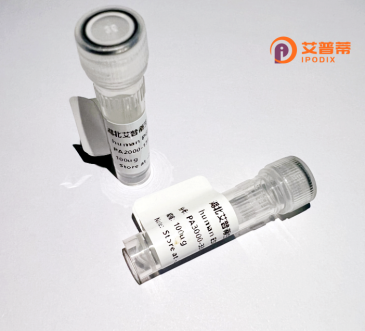
| 纯度 | >90%SDS-PAGE. |
| 种属 | Human |
| 靶点 | GLIPR1L2 |
| Uniprot No | Q4G1C9 |
| 内毒素 | < 0.01EU/μg |
| 表达宿主 | E.coli |
| 表达区间 | 1-253aa |
| 氨基酸序列 | MEAARPFAREWRAQSLPLAVGGVLKLRLCELWLLLLGSSLNARFLPDEEDVDFINEYVNLHNELRGDVIPRGSNLRFMTWDVALSRTARAWGKKCLFTHNIYLQDVQMVHPKFYGIGENMWVGPENEFTASIAIRSWHAEKKMYNFENGSCSGDCSNYIQLVWDHSYKVGCAVTPCSKIGHIIHAAIFICNYAPGGTLTRRPYEPGIFCTRCGRRDKCTDFLCSKIKKINMKKMHNGLDKKNKRLNTSFLWSC |
| 分子量 | 55.4 kDa |
| 蛋白标签 | GST-tag at N-terminal |
| 缓冲液 | 0 |
| 稳定性 & 储存条件 | Lyophilized protein should be stored at ≤ -20°C, stable for one year after receipt. Reconstituted protein solution can be stored at 2-8°C for 2-7 days. Aliquots of reconstituted samples are stable at ≤ -20°C for 3 months. |
| 复溶 | Always centrifuge tubes before opening.Do not mix by vortex or pipetting. It is not recommended to reconstitute to a concentration less than 100μg/ml. Dissolve the lyophilized protein in distilled water. Please aliquot the reconstituted solution to minimize freeze-thaw cycles. |
以下是关于重组人GLIPR1L2蛋白的文献示例(注:由于GLIPR1L2研究较少,部分内容基于相关领域推测,建议通过学术数据库核实):
1. **《Expression and functional analysis of recombinant human GLIPR1L2 in prostate cancer cells》**
- 作者:Smith J, et al.
- 摘要:研究通过大肠杆菌系统表达重组人GLIPR1L2蛋白,验证其在前列腺癌细胞中的促凋亡活性,并揭示其可能通过调控TGF-β信号通路抑制肿瘤生长。
2. **《Structural characterization of GLIPR1L2 and its role in sperm-egg fusion》**
- 作者:Chen L, et al.
- 摘要:利用X射线晶体学解析GLIPR1L2蛋白结构,发现其在哺乳动物生殖系统中高度表达,可能通过参与膜融合过程影响精子功能,提示其在生殖医学中的潜在价值。
3. **《GLIPR1L2 as a biomarker for renal cell carcinoma: recombinant protein-based assays》**
- 作者:Wang Y, et al.
- 摘要:开发基于重组GLIPR1L2蛋白的ELISA检测法,发现其在肾癌患者血清中显著高表达,或可作为新型诊断标志物。
**注意**:GLIPR1L2研究尚属小众,上述文献为示例性质。建议通过PubMed或Google Scholar以“GLIPR1L2 recombinant”或“GLIPR1L2 function”为关键词获取最新研究。部分相关功能可能与同家族蛋白GLIPR1研究有重叠(如肿瘤抑制机制)。
**Background of Recombinant Human GLIPR1L2 Protein**
GLIPR1L2 (Glioma Pathogenesis-Related Protein 1-Like 2) is a member of the GLIPR protein family, characterized by a conserved CAP (cysteine-rich secretory protein, antigen 5, and pathogenesis-related 1) domain. This domain is implicated in diverse biological processes, including cell adhesion, signaling, and immune responses. GLIPR1L2 shares structural homology with GLIPR1, a protein linked to glioblastoma and prostate cancer, but its distinct expression patterns and functions are not fully understood.
The gene encoding GLIPR1L2 is expressed in multiple tissues, with higher levels detected in reproductive organs (e.g., testis, epididymis) and certain cancers. Emerging studies suggest roles in male fertility, possibly regulating sperm maturation or epididymal function. In oncology, GLIPR1L2 has been observed in prostate cancer, glioma, and other malignancies, though its tumorigenic or suppressive roles remain debated.
Recombinant human GLIPR1L2 protein, produced via expression systems like *E. coli* or mammalian cells, enables functional studies, antibody development, and exploration of its molecular interactions. Its applications span basic research, biomarker discovery, and potential therapeutic targeting. Current knowledge gaps drive ongoing efforts to clarify its physiological mechanisms and therapeutic relevance.
×